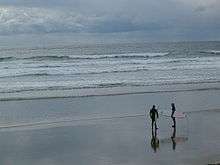Surfing in Canada
Surfing in Canada is practised on its east and west coasts, as well as via lake surfing on the Great Lakes, and river surfing on standing waves and tidal bores.

Ocean surfing
The Pacific Ocean on the west coast of Canada has the most active surf scene in Canada.[1] Tofino, British Columbia is the unofficial surf capital of Canada. Canada's west coast has surfable waves year-round, and Tofino was listed in the world's Top 50 surf destinations by CNN[2] and Outdoor Magazine named Tofino the 'best surf town' in North America in 2010.[3] In Tofino, ocean water temperatures are consistent year-round, averaging 8-12 degrees (C), and advancements in wetsuit technologies are attributed with making year-round surfing comfortable and safe. Bordered by an old growth rainforest, Tofino also has the most temperate climate in Canada.[4][5] The Atlantic Ocean on Canada's east coast also has a growing surfing scene.[6] Tofino has remained relatively undeveloped due to its proximity to Clayoquot Sound, a UNESCO-protected biosphere reserve.[7]
River surfing
On 24 July 2013, the North American record for surfing a single river wave was set on the Petitcodiac River's tidal bore, in New Brunswick.[8]
The Lachine Rapids in St. Lawrence River in Montreal is home to the Habitat 67 standing wave.[9] The Ottawa River in Ottawa also has an active river surfing community.[10] There are also growing river surfing scenes in traditionally inland prairie areas like Alberta, and Manitoba.[11]
Lake surfing
The Great Lakes in Ontario have an active surf scene.[12] There are surf communities on Lake Huron, Lake Erie, Lake Ontario, and Lake Superior.[13] The Wyldewood Surf Club, dedicated to lake surfing, was established in Port Colborne in 1965.
Competitions
Canada will try to participate in the 2020 Olympics surfing events, and the country's representatives were decided in May 2019, in Tofino, right after the Rip Curl Nationals.[14]
See also
References
- http://www.surfing-canada.com/west-coast.html
- World's 50 best surf spots
- "Tofino named 'best surf town' in North America | CTV Vancouver News". Bc.ctvnews.ca. 2010-02-23. Retrieved 2016-09-23.
- "Winter surfing in Canada, eh? - CNN iReport". CNN.
- "Surfing | The Official Tourism Tofino". Tourismtofino.com. 2016-07-28. Retrieved 2016-09-23.
- http://www.surfing-canada.com/East-coast.html
- Surfing holiday in Tofino, Canada at Perth Now Travel
- "Surfers set record after 29 km ride on Moncton tidal bore". CBC News. 25 July 2013. Retrieved 26 July 2013.
- Lamey, Mary. "Everybody's gone surfin' on the St. Lawrence River". Montreal Gazette. Canwest. Archived from the original on 2010-02-27. Retrieved 2009-07-11.
- http://www.surfing-canada.com/river-surfing.html
- http://vueweekly.com/outdoors/story/hawaiistyle_surfing_in_alberta/
- "Surf's up: Catching a wave in Lake Ontario". Thespec.com. 2012-03-19. Retrieved 2016-09-23.
- http://www.surfing-waves.com/atlas/north_america/canada/great_lakes_canada.html
- Nora O'Malley (2019-05-18). "Tofino athletes Devries, Olin selected for Surf Canada Olympic pathway team". Westerly News.
| Wikimedia Commons has media related to Surfing in Canada. |